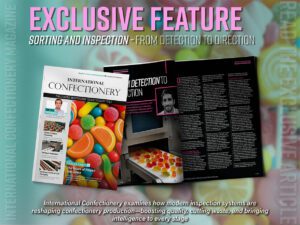In this exclusive feature, we hear from an industry expert and this edition’s Technical Expert Contributor, Dr Richard Parmee, who discusses the emerging inspection technology.
This exclusive edition of International Confectionery has a great focus around hard candy production. It is fair to say that hard candy production heavily relies on inspection systems to ensure that these complex confectionery goods meet a high food standard and are aesthetically pleasing. With that being said, the International Confectionery team were lucky enough to meet a brilliant mind who has access to a vast amount of knowledge in the inspection world. Here, I (Roshini Bains) conversed with Richard Parmee, a technical expert in food inspection systems. Richard Parmee kindly offered to provide technical insight into the intricate world of inspection systems and how they are adapting.
An expert piece from Richard Parmee
Inspection of confectionery to ensure it is free of foreign bodies has been a routine feature of factory production lines for decades. But the latest X-ray inspection technology can do so much more than detect a fragment of metal or glass in a bag of sweets.
Has an apple pie got the correct amount of filling, for example – and is it evenly distributed within the product? Are there any missing or damaged items in a multipack? Does a box of chocolates have any missing chocolates – and all the right chocolates in the correct places? Has every doughnut been filled with jam?
All these questions – and more – are being answered by a new generation of X-ray inspection technology that can do far more than meets the eye.
Accurate and repeatable measurements of the mass of material within a particular region of a product is a useful feature of X-ray inspection. The technology not only checks the mass of a family-size apple pie, for example, to ensure it meets weight requirements – it can also check the individual masses of a series of items within a pack. So, in a pack containing six apple pies, the one pie with less filling than the others will be identified and rejected – even if the remaining five pies have slightly too much filling.
This aspect of the technology is also useful for checking that moulded chocolate bars are not missing their wafer filling. If the moulds accidentally get filled with chocolate, which is more expensive, the cost to the manufacturer can be more than £500,000 per year on each production line. By identifying products with a partial or fully solid finger, and rejecting the product for reprocessing, much of that value can be recovered – at a price considerably lower than the annual savings.
The same technique can also be used to check that each doughnut has been filled with the correct amount of jam, giving an early warning of any problems with jam nozzles becoming blocked – before it gets to the point where the product’s quality standards are no longer being met. This avoids non-conformant products being manufactured in the first place and so helps reduce waste.
Another example is a box of chocolates that needs to have the right chocolates in the correct positions. A big advantage of X-ray technology is that it can check everything is in the right place after the boxes are wrapped and sealed – so at a point where nothing else can go wrong. It is even possible to monitor and track individual products after they leave the factory to provide protection against ‘fake’ complaints.
Read more of the latest industry news and developments here: April 2022 Single Issue form – International Confectionery Magazine (in-confectionery.com)
Media contact
Roshini Bains,
Editor, International Confectionery
Tel: +44 (0) 1622 823 922
Email: [email protected]








